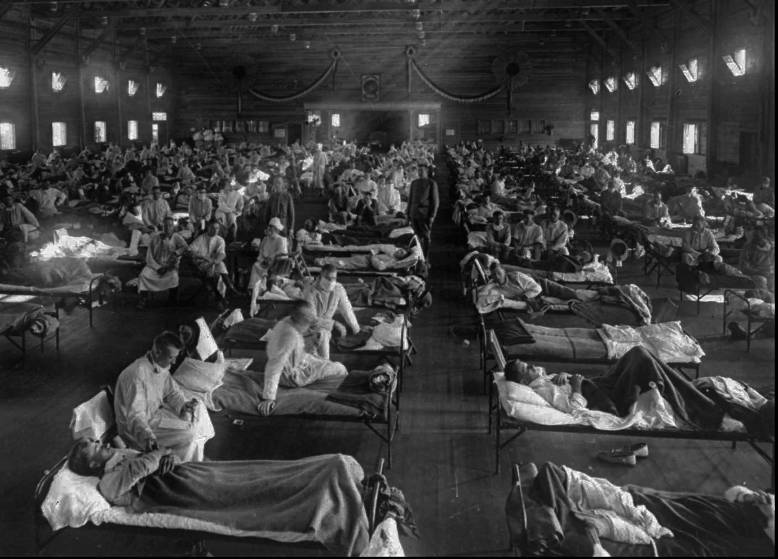|
Influenza or 'the flu' is a disease caused by viruses. There are many different types of flu virus and some can be very deadly.
One of the most deadly variations in all of human history was the Spanish Flu. It came to prominence in 1918 as the First World War
ended. It was caused by the H1N1 virus and is thought to have spread to 500 million people world-wide.
Unlike many other virus outbreaks, the Spanish Flu attacked and killed a higher percentage of healthy young adults than would normally be
expected. Most viruses kill more young children or old and sick people but in this case the virus triggered an over-reaction of the body's
immune system which seems to have led to death in many cases.
Although it was nicknamed 'Spanish Flu' there is no evidence that the virus originated there. Spain did not censor reports of deaths as was
done in other countries so it became more associated with the effects of the disease.
The widespread distribution of the flu stemmed from the large scale movement of soldiers from one part of the world to another.
The final death toll from this pandemic will never be known but estimates range up to 100 million people.
The disease touched virtually every human population and eventually it made its way to Western Australia. To give some perspective on the rates of death,
normal flu may kill around 0.1% of those infected but Spanish Flu killed up to 20%.
The West Australian newspaper reported (on December 1st 1918) that a troopship was approaching Fremantle carrying troops with about
100 cases of the dreaded influenza. Western Australians were already fully aware of the progress of the disease in Europe and there was great concern about the
effect the arrival of a ship carrying so many cases would have on the local population.
The trop ship Boonah arrived in Gage Roads on December 11th 1918 and dropped anchor. The ship was quarantined and anyone going aboard would have to return
to the mainland via the quarantine station at Woodman Point.
When the ship was inspected it was found that 337 men were ill. It took three days for the sick men to be off-loaded but the next problem was a lack of medical
staff to tend to them. Australian Army nurses aboard another vessel in Gage Roads volunteered their services even though they knew the grave danger they would
be placed in. Twenty nurses came ashore instead of resuming their voyage east and three were destined never to leave.
Armed guards were put in place to ensure no-one from the quarantine station left the premises and contact with the station was restricted to the phone.
Two days after the Boonah had arrived a second troop ship, the H.M.A.T. Port Lyttelton dropped anchor. At first she was given clearance to enter
port but due to some cases of flu on board this was rescinded and she was ordered to continue on to Melbourne. This was too much for a West Australian contingent
on board and they mutinied, dropped 4 life boats and headed for shore. They were rounded up before landing but refused to return to their ship. In the end they
agreed to enter quarantine at Woodman Point.
Cases of influenza continued to break out on the Boonah and the number of men sent into quarantine rose to 381 and the death toll had already reached 8.
The men still in quarantine aboard the Boonah tried to make the best of things. Some even started fishing and caught a number of sharks and large fish
some of which were deposited in the ship's pool to keep them fresh.
The press soon took up the case of the men stuck on the ship and called for them to be released onto Garden Island or
Rottnest Island. This request was ignored by the authorities.
Meanwhile Woodman Point was starting to become overcrowded. Built to house 500 people at most it was now housing 600.
By December 20th the Boonah had been declared a 'clean ship' and resumed her journey east. Unfortunately for those at Woodman Point the ordeal still
continued.
On December 22nd came the news that Sister Rosa O'Kane, one of the volunteer nurses had died.
The Boonah stopped in at Albany to re-supply and locals were told that no new cases of influenza had developed. This may not have been
true as by the time the ship reached Adelaide, there were 14 new cases on board. The men were quarantined (this time on an island) for a further three weeks
before finally being transferred to the mainland.
Deaths at Woodman Point continued into the new year and in total 4 nursing staff succumbed along with the soldiers.
Despite attempts to contain the disease, it eventually entered the civilian population. Estimates put the death toll in Australia at about 12,000. Western
Australia fared better than the more populous eastern states but even so 638 people are known to have died from it here. A free inoculation in W.A. was
available and health authorities administered almost 95,000 doses of vaccine
|







